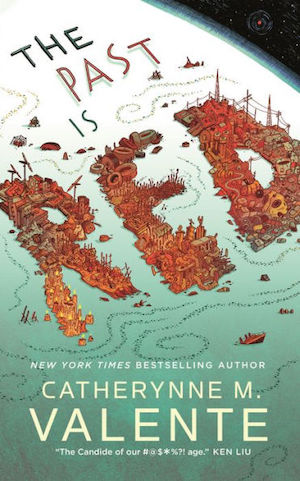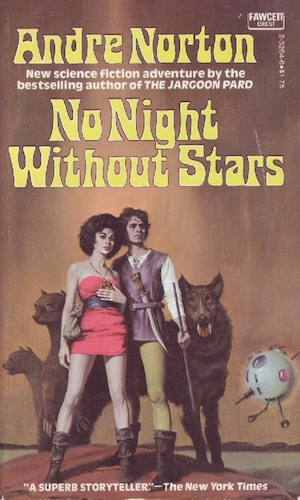No Night Without Stars was a formative novel for me. It came out in 1975, and I read it while it was still new. It gave me ideas, and a few names that I loved the sound of and adapted for my own work in the following decade or two.
All that was left of it when I picked it up again, decades later, was a memory of names and a dim recollection of the plot. Unlike, say, Moon of Three Rings or The Crystal Gryphon, it hadn’t stayed with me. It read almost like new, but through the lens of 2021 rather than 1975.
It hasn’t held up particularly well. There are worse Norton novels, and some far more dated. Mostly it’s kind of inoffensive, as Seventies postapocalyptic science fiction goes. There’s nothing remarkable or memorable about it.
The field was changing dramatically by the time it was published. Feminism had grown strong, and such now classic authors as Russ and Le Guin, Delany and McIntyre, were at the height of their powers. Norton was still to a degree cruising along in the Fifties and early Sixties, revisiting yet again her vision of a world destroyed by nuclear holocaust, with survivors picking their way among the ruins.
It’s a familiar plot. Newly orphaned male protagonist is driven away from the place where he was born, forced to make his own way in an inimical world. He meets and fights monsters. He deals with natural disasters both old and new. He has a mutant animal companion. He meets another human, also with animal companions, and they join forces to achieve a mutual goal.
In this case it’s Sander from the Midwest with his giant riding coyote, hunting for remnants of ancient metal to which he can apply his smithing skills. He meets Fanyi with her pair of giant fisher cats. Fanyi’s village was destroyed by sea slavers while she was away on a shamanic journey. She is the offspring of a line of female shamans and a stranger from a mysterious installation of the ancients; guided by a pendant he left her, she’s looking for the installation and the knowledge it contains.
Sander goes along with her because she’s looking for more or less the same thing he is, though with a different emphasis. Sander is a pure empiricist, and pretty solidly an atheist. He just wants metal to forge so he can show his people how wrong they were to give his unimaginative but fully mature uncle the smith’s job instead of passing it on to the smith’s young and less experienced son. Fanyi is a shaman, and she’s looking for insight into the Before Men’s magic. She also has psychic powers, which Sander persistently refuses to believe in.
Sander is a bit of a jerk. He disses Fanyi’s powers even when they prove to be real. He grabs the lead more often than not, and gets all bent out of shape when she doesn’t defer to his authority. He’s especially snorked when she dares to presume that she might have skills and knowledge beyond his own.
Buy the Book


The Past Is Red
It feels as if this might have been an older plot or outline which Norton repurposed to sell. Sander assumes Fifties gender roles, and so does Fanyi: she does the cooking, he does most of the fighting. And yet, just about the time I was ready to smack them both upside the head, suddenly I was informed that women in this world are basically in charge, choose their own husbands, and make most of the rules. I never would have guessed from context up to that point. I wondered, uncharitably, if Norton herself had, or if she’d suddenly decided to wake up to the Seventies.
In the Seventies, I don’t think I noticed any of this. I let the plot pull me along, however generic it happened to be. The orphan fighting monsters in blasted ruins was standard Norton and fairly standard Sixties and Seventies postapocalyptica. And then at the end, for extra points, we got a favorite theme of the period, the rogue computer mind-controlling humans and plotting to destroy them all.
Norton did a lot of that, not only in her post-nuclear Earth but in various Forerunner novels and even in the Witch World. It’s quite formulaic here. The characters don’t stand out. The animals are very cool, but we never really get close to them, because Sander doesn’t; he doesn’t believe enough in mental powers, and he’s too stubborn in clinging to Just The Observable Facts, Ma’am. I’d have liked more of what’s going on inside their heads, and less of Sander’s obstinate empiricism.
No, I don’t like Sander. He does mellow out eventually. Sort of. He remains a jerk to the end.
While I read, kept getting echoes, not so much of written as of television science fiction. Original Star Trek did a number of Rogue Computer episodes, which might possibly have influenced Norton’s version. And then there’s the whole deal with the eagle symbol, which has echoes of a couple of episodes including “The Omega Glory.”
And then there’s the sequence with the White Ones with their all-white skin and hair and their silver eyes, riding their giant moose-elk against an army of giant mutant frogs. They’re under the control of the evil AI, and they’re out to destroy all life. I wonder if George R.R. Martin had that scene in mind when he wrote his White Walkers. The famous scene in the second season of the TV series could almost work for a filmed version of No Night Without Stars.
Unlike the Game of Thrones series, however, Norton’s dystopia has a strong strain of hope. The title gives it away. The point of Sander and Fanyi’s journey is to prove that their world needs to stop looking backward to the old ways and technologies. It needs to look forward, to make its own way, in its own way.
Next I’ll reread another all-but-forgotten title, Perilous Dreams.
Judith Tarr’s first novel, The Isle of Glass, appeared in 1985. Since then she’s written novels and shorter works of historical fiction and historical fantasy and epic fantasy and space opera and contemporary fantasy, many of which have been reborn as ebooks. She has written a primer for writers: Writing Horses: The Fine Art of Getting It Right. She has won the Crawford Award, and been a finalist for the World Fantasy Award and the Locus Award. She lives in Arizona with an assortment of cats, a blue-eyed dog, and a herd of Lipizzan horses.










